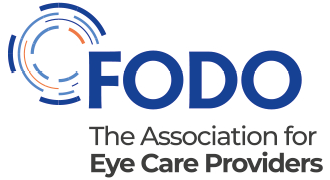Updates
Background
This guidance was published in response to a concern raised by Trading Standards. It sets out practical steps you should take as a practice owner if you intend to glaze display frames and aims to help you manage the risk of any inadvertent breach of the Consumer Protection from Unfair Trading Regulations 2008 ('the Regulations') [1].
The need for action
With clothing and non-prescription sunglasses, it is immediately obvious to the consumer that the garment or sunglasses they try on is what they will purchase. Although the same principle applies to prescription spectacle frames - indeed more so as the frames have to be measured and fitted before glazing - Trading Standards has queried whether patients in general know that the frame they try on from display will be the actual frame that they will purchase once glazed. While this may seem obvious to those of us working in the sector, customers may not always be aware of it.
So, even if it is obvious because your interaction involves, for example, fitting the frame and placing it in an order tray, you still need to ensure the customer understands the display frame is what they will be buying.
You must do this because if a customer complains to a local Trading Standards Officer that they were not aware, then this could have legal, NHS and GOC implications.
In 2018 Trading Standards raised concerns about whether patients buying spectacle frames are generally aware that the display frames they try on might be the frames they are purchasing and which will be glazed for them. Trading Standards was concerned that sales of display frames in these circumstances may breach the Consumer Protection from Unfair Trading Regulations 2008.
Legal advice obtained by the Optical Confederation confirms that if a practice doesn't explain the position to consumers, there is a genuine risk that a customer complaint about this to a local Trading Standards Officer could result in a criminal prosecution and conviction for breach of the Regulations. This would, in turn, be reportable to the GOC and the NHS. We have therefore provided this guidance to help your practice meet the requirements of the Regulations.Steps to take
We recommend that if you sell frames from display, you should review the information provided to customers.
The following practical steps will reduce the risk of breaching the Regulations, and we recommend that as a minimum, if you do not already do so, you should:
- Display a sufficiently prominent notice(s) to the effect that 'Frames on display may be those sold'
- Where a frame is being sold from display, check that customers are fully happy and explain that these will be the frames which will be sent away to have lenses fitted in line with the measurements taken
- If you see any defects or issues with display frames being purchased, point these out to the customer and note that you have done so and any action agreed.
In addition, if practical to do so:
- Provide an information slip or wording on the customer order form that the frames the customer has tried on are the ones they are buying.
Taking these steps will show the customer has been given sufficient information to be fully aware of the circumstances of the sale. They also provide an opportunity to explain to customers that they are receiving a bespoke item which is tailored to their requirements.
Background - the Consumer Protection from Unfair Trading Regulations 2008
The Regulations [1] are a 'consumer friendly' piece of legislation where any doubt or legal proceedings are likely to be resolved in favour of the consumer.
The Regulations prohibit a range of 'unfair commercial practices', including misleading omissions [2]. In particular:
- Omission of material information: A commercial practice is a misleading omission if, in its factual context, it omits material information and, as a result, it causes or is likely to cause the average consumer to take a transactional decision he/she would not have taken otherwise [3]
- Definition of 'material information': Material information is defined as the information which the average consumer needs, according to the context, to take an informed transactional decision [4]
- Invitations to purchase: Where a commercial practice is an invitation to purchase, material information will include the main characteristics of the product to the extent appropriate to the medium by which the invitation to purchase is communicated and the product [5].
Selling frames which are (or have previously been) on display, and not informing the customer of this, may be viewed by the courts as a 'misleading omission'. This is because information as to whether the spectacle frames being sold were those on display may affect a customer's decision to buy. For example, a customer may be concerned that there would be an increased possibility of wear and tear on display pairs and either seek a discount or wait until a boxed pair was available.
So, practices must ensure that customers are given information about what they are being sold.
Penalties
Under the Regulations, Trading Standards has no power other than to prosecute; it is cannot issue a formal warning or a civil penalty as a way of dealing with breaches proportionately and allowing a seller to modify its practices to avoid prosecution. Penalties can be high: the penalty for an offence is an unlimited fine and/or imprisonment for a maximum of two years [6], although in practice, unlimited fines and prison sentences will only apply to the most extreme conduct under the Regulations.
For optical bodies corporate registered with the General Optical Council this would be declarable and in turn would trigger an investigation into the business's or its owner's fitness to practise.
Updates
Originally published: March 2018
Reviewed: January 2020
Next review date: November 2022
Info: This OC guidance was originally published in March 2018 and in January 2020 converted into an online resource with minor grammatical changes made. No material changes made.
Reference and notes
[1] To see a copy of the Regulations go to: http://www.legislation.gov.uk/uksi/2008/1277/contents/made accessed on 22 January 2018. 2 Regulation 3(1)
[2] Regulation 3(4)(b)
[3] Regulation 6(1)(a)
[4] Regulation 6(3)(a)
[5] Regulation 6(4)(a)
[6] Regulation 13.

 Patients and public
Patients and public
 Policymakers
Policymakers Members
Members News and views
News and views
